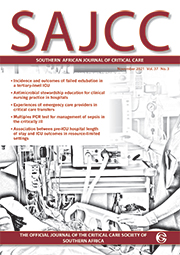Articles

The effect of intra-abdominal hypertension on gastrointestinal function
Abstract
Introduction: Intra-abdominal hypertension (IAH) is a frequent occurrence in critically ill patients. Raised intra-abdominal pressure negatively affects gastrointestinal function and may reduce the success of enteral nutrition support, which in turn is associated with adverse clinical outcomes.
Aim: To evaluate the impact of raised intra-abdominal pressure on gastrointestinal function and success of enteral nutrition support in an adult ICU population at risk for abdominal compartment syndrome.
Methods: In a prospective observational study, critically ill patients, in whom IAP was monitored routinely for clinical indications, were assessed for gastrointestinal symptoms, methods of nutrition support and enteral feeding success on a daily basis.
Results: In total, data from 17 patients for a total of 98 patient days was included in the study. The mean intra-abdominal pressure (IAP) was 14.0 ± 3.7 on admission to the intensive care unit (ICU). There were 10 patients with Grade I IAH, 2 with Grade II IAH and 2 with Grade III IAH. Seven (41%) patients developed abdominal compartment syndrome. Abdominal perfusion pressure was inversely related to IAP (r = -0.35, p=0.0002) and positively correlated with mean arterial pressure (r = 0.96, p= 0.000). Gastrointestinal (GI) symptoms occurred commonly in patients with IAH, and days of IAH correlated positively with number of GI symptoms (r=0.85, p=0.000). Exclusive enteral feeding was possible on 32% of study days. A 12% incidence of enteral feeding intolerance and 59% incidence of enteral feed failure occurred. Enteral feeding failure was associated with both IAH (r= 0.43, p=0.08) and number of GI symptoms (r= 0.67, p= 0.003). Days of IAH was positively associated with longer ICU stay (r = 0.65, p=0.005), as was prevalence of IAH combined with concurrent GI symptoms (r=0.71, p=0.001). Mortality was 17% and occurred only among patients who developed abdominal compartment syndrome.
Conclusion: Raised intra-abdominal pressure was associated with poorer gastrointestinal function, enteral feed intolerance, length of hospital stay and mortality.
Aim: To evaluate the impact of raised intra-abdominal pressure on gastrointestinal function and success of enteral nutrition support in an adult ICU population at risk for abdominal compartment syndrome.
Methods: In a prospective observational study, critically ill patients, in whom IAP was monitored routinely for clinical indications, were assessed for gastrointestinal symptoms, methods of nutrition support and enteral feeding success on a daily basis.
Results: In total, data from 17 patients for a total of 98 patient days was included in the study. The mean intra-abdominal pressure (IAP) was 14.0 ± 3.7 on admission to the intensive care unit (ICU). There were 10 patients with Grade I IAH, 2 with Grade II IAH and 2 with Grade III IAH. Seven (41%) patients developed abdominal compartment syndrome. Abdominal perfusion pressure was inversely related to IAP (r = -0.35, p=0.0002) and positively correlated with mean arterial pressure (r = 0.96, p= 0.000). Gastrointestinal (GI) symptoms occurred commonly in patients with IAH, and days of IAH correlated positively with number of GI symptoms (r=0.85, p=0.000). Exclusive enteral feeding was possible on 32% of study days. A 12% incidence of enteral feeding intolerance and 59% incidence of enteral feed failure occurred. Enteral feeding failure was associated with both IAH (r= 0.43, p=0.08) and number of GI symptoms (r= 0.67, p= 0.003). Days of IAH was positively associated with longer ICU stay (r = 0.65, p=0.005), as was prevalence of IAH combined with concurrent GI symptoms (r=0.71, p=0.001). Mortality was 17% and occurred only among patients who developed abdominal compartment syndrome.
Conclusion: Raised intra-abdominal pressure was associated with poorer gastrointestinal function, enteral feed intolerance, length of hospital stay and mortality.
Authors' affiliations
Lauren Hill, University of Cape Town
Bridget Hill,
Malcolm Miller, University of Cape Town
William Lance Michell, University of Cape Town
Keywords
Intra-abdominal pressure (IAP), Intra-abdominal hypertension; Abdominal Compartment Syndrome; Abdominal Perfusion Pressure; Enteral nutrition
Cite this article
Southern African Journal of Critical Care 2011;27(1):12, 14, 16, 18, 20.
Article History
Date submitted: 2011-05-27
Date published: 2011-07-28
Date published: 2011-07-28
Article Views
Abstract views: 3806
Full text views: 5934
Full text views: 5934




1.jpg)
Comments on this article
*Read our policy for posting comments here